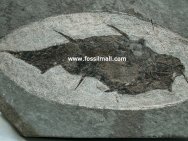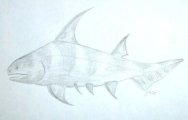Ischnacanthus
gracilis
Class Acanthodii,
Order Ischnacanthiformes
Geological
Time: Lower Devonian
Size: 95
mm in length on 118 mm by 78 mm matrix
Fossil Site:
Tillywhandland Quarry, Forfar, Scotland
|  Description:
The Acanthodians are jaw-bearing fish who still are the subject
of dispute over their systematic position. They possess highly advanced,
spindle-shaped bodies thought to have made them swift swimmers.
The body was covered in small mosaic-like scales. They Description:
The Acanthodians are jaw-bearing fish who still are the subject
of dispute over their systematic position. They possess highly advanced,
spindle-shaped bodies thought to have made them swift swimmers.
The body was covered in small mosaic-like scales. They  possessed
small teeth which were typically confined to the lower jaw; some
were toothless. The feature they all share in common is the fact
that all fins other than the caudal are supported by massive spines
formed of dentine. Indeed, the name Acanthodii is derived from the
Greek word for spine. The oldest acanthodian lived during the late
Ordovicain. They reached their peak during the Devonian, and became
extinct during the Great Dying of the end-Permian extinction. This
well-preserved example is known as Ischnacanthus; the genus derives
its name from the thinner spines it possessed. The ischnacanthids
lived from Late Silurian to Late Carboniferous time, and have been
found in both freshwater and saltwater deposits. possessed
small teeth which were typically confined to the lower jaw; some
were toothless. The feature they all share in common is the fact
that all fins other than the caudal are supported by massive spines
formed of dentine. Indeed, the name Acanthodii is derived from the
Greek word for spine. The oldest acanthodian lived during the late
Ordovicain. They reached their peak during the Devonian, and became
extinct during the Great Dying of the end-Permian extinction. This
well-preserved example is known as Ischnacanthus; the genus derives
its name from the thinner spines it possessed. The ischnacanthids
lived from Late Silurian to Late Carboniferous time, and have been
found in both freshwater and saltwater deposits.
All
the diagnostic features of the taxon are displayed within this high-quality
specimen which has recently been obtained from a 50 year old collection.
|
|